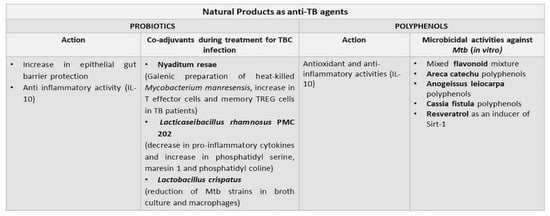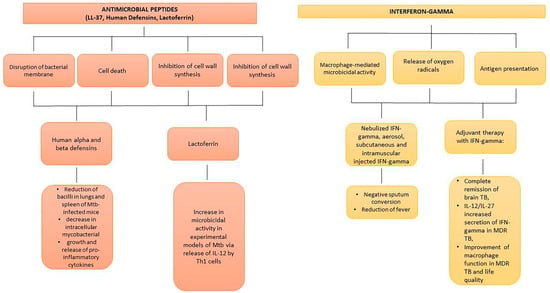Tuberculosis (TB) is an infectious disease caused by the bacillus Mycobacterium tuberculosis (Mtb). TB treatment is based on the administration of three major antibiotics: isoniazid, rifampicin, and pyrazinamide. However, multi-drug resistant (MDR) Mtb strains are increasing around the world, thus, allowing TB to spread around the world. The stringent response is demonstrated by Mtb strains in order to survive under hostile circumstances, even including exposure to antibiotics. The stringent response is mediated by alarmones, which regulate bacterial replication, transcription and translation. Moreover, the Mtb cell wall contributes to the mechanism of antibiotic resistance along with efflux pump activation and biofilm formation.
1. Probiotics
There is evidence that antibiotics against TB alter the gut and pulmonary microbiota
[1][91]. Moreover, antibiotic-mediated dysbiosis may affect the microbiota–immune axis, thus, aggravating the clinical course of TB and increasing the risk of reinfection
[2][3][65,92]. Probiotics have been identified by the WHO as “Living microorganisms that when administered in adequate amounts as a part of food confer a health benefit to the host”
[4][93]. Just recently, the bactericidal activity of probiotics has been demonstrated to suppress a few antibiotic-resistant superbugs and, therefore, attempts have been made to apply them against tuberculosis
[5][94]. In general terms, probiotics are able to increase the protective effect of the intestinal epithelial barrier, also shifting the immune profile towards a tolerogenic pathway with the production of IL-10 by TREG cells
[6][7][95,96].
Experimentally, the probiotic Nyaditum resae
® (Nr), enriched in heat-killed Mycobacterium manresensis, abrogated the development of active murine TB, through increasing the function of memory TREG cells
[8][97]. Furthermore, Nr effects were evaluated in patients with or without latent TB infection and an increase in T effector cells and memory TREG cells was observed
[9][98].
Lacticaseibacillus rhamnosus PMC203, isolated from the vaginal microbiota of healthy women has been shown to exhibit an effective killing of drug-sensitive and drug-resistant
Mtb infecting RAW macrophages, also inhibiting
Mtb growth under broth culture medium
[10][99].
L. casei supplemented to TB patients for four weeks led to a dramatic reduction of TNF-alpha, IL-6, IL-10, and IL-12, with an up-regulation of metabolites, such as phosphatidylserine, maresin 1, and phosphatidylcholine
[11][100].
L. crispatus, isolated from the vaginal microbiota of healthy women, reduced the growth of MtbH37Rv in broth, and MtbH37Rv and
Mtb XDR TBs in macrophages
[12][101].
2. Polyphenols
Polyphenols are natural products largely contained in fruits, vegetables, cereals, red wine, and extra virgin olive oil
[13][27]. They are endowed with antioxidant, anti-inflammatory, and microbicidal activities and, therefore, they are currently used in the prevention or treatment of chronic disease
[14][28]. In fact, polyphenols exert their anti-inflammatory activity either inhibiting the NF-kB pathway with reduced expression of pro-inflammatory cytokines or activating TREG cells with the enhanced expression of the anti-inflammatory cytokine IL-10.
The use of polyphenols in the treatment of TB has been poorly investigated. A mixed flavonoid mixture treatment of TPH-1 infected macrophages and human granuloma reduced the intracellular survival of
Mtb and increased granuloma formation, with higher levels of IL-12 and IFN-gamma, and lower levels of IL-10
[15][102]. Polyphenols, extracted from Areca catechu and enriched in catechin, epicatechin, and epigallocatechin, were able to inhibit
Mtb growth
[16][103]. Polyphenols extracted from the roots of
Anogeissus (A.) leiocarpa could inhibit Mycobacterium smegmatis growth in view of high concentration of ellagic acid derivatives, ellagitannins, and flavonoids
[17][104]. Clinical data support the use of
A. leiocarpa in the treatment of cough related to TB. A saponin-polybrophenol antibiotic (CU1), extracted from Cassia fistula inhibited transcription from
Mtb polymerases, and its ethanol extract was very effective against MDR bacteria
[18][105]. Sirtuin (Sirt) 1 is a NAD-dependent deacetylase, that is able to inhibit apoptosis and inflammation in human cells
[19][106]. Resveratrol, a non-flavonoid polyphenol, is a Sirt 1 activator, which abrogated
Mtb-induced apoptosis in peritoneal macrophages
[20][107]. Furthermore, Sirt 1 inhibited
Mtb growth, enhancing GSK3 beta phosphorylation, thus, inducing its deacylation. Therefore, Sirt 1 can be considered as potential anti-TB agent. The use of natural products as anti-TB agents is described in
Figure 13.
Figure 13. Potential use of natural products as anti-TB agents. Both probiotics and polyphenols have been experimented with as anti-TB pharmaceuticals. Probiotics can modulate the gut–lung axis that is compromised in the course of TB. Polyphenols exert anti-TB microbicidal activity in vitro and their application in human TB needs to be better explored.
3. Antimicrobial Peptides
AMPs have been shown to act as antimicrobial compounds alone or in combination with other drugs
[21][22][23][24][108,109,110,111]. In general terms, they are cationic with less than 50 amino acid residues. Additionally, synthetic analogues are more effective than natural AMPs demonstrating a lower minimum inhibitory concentration
[25][112]. AMPs act through different modalities: i. Disruption of bacterial membrane with formation of pores or via electroporation; ii. Interaction with bacterial components and cell death induction; iii. Inhibition of cell wall biosynthesis; iv. Antimicrobial activity mediated via the activation of the innate immune system
[26][27][28][113,114,115]. Cathelicidins, human defensins, and lactoferrin (LF) are the major categories of AMPs. LL-37 is a human cathelicidin, that is able to bind to the negatively charged outer leaflet of the microbial membrane, leading to its disruption
[29][116]. In addition, LL-37 exerts its microbicidal activity against
Mtb via modulation of the innate immune response
[30][117]. In the course of
Mtb infection, LL-37 was expressed following the up-regulation of the vitamin D receptor, as well as after oral administration of phenylbutyrate and vitamin D3, with reduction of the intracellular burden of
Mtb [31][32][118,119]. Of note, LL-37 stimulation of infected macrophages led to the production of anti-inflammatory cytokines, IL-10 and TGF-beta, thus, suggesting a modulation of the immune response in the earlier phase of
Mtb infection
[33][120]. Among analogues of AMPs, acyl depsipeptides (ADEPs) seem to represent a future generation of antibiotics against tuberculosis
[34][121]. ADEPs exert antibacterial activity on
Mtb strains through activation of the caseinolytic protease ClpP1P2. Biotherapeutics for the treatment of TB are indicated in
Figure 24.
Figure 24. Biotherapeutics for treatment of experimental and human TB. AMPs target Mtb in different ways, inhibiting intracellular mycobacterial growth and reducing pro-inflammatory cytokines and IL-12 release by Th1 cells. Nebulized, aerosol, subcutaneous, and intramuscular IFN-gamma administration leads to sputum conversion, reduction of fever, and improvement of life quality in severe human TB.
4. Interferon-Gamma and Mesenchymal Stem Cells
IFN-gamma represents a protective cytokine against TB progression that is produced by Th1 and T cytotoxic lymphocytes a few days after infection
[35][36][37][122,123,124]. Several genes that encode IFN-gamma and its receptors are required for anti-TB response to occur
[38][125]. In particular, IFN-gamma potentiates the microbicidal response of macrophages, with the release of nitric oxide and reactive oxygen species, and the enhancement of antigen presentation
[39][126]. In TB patients infected with a MDR
Mtb strain, levels of IFN-gamma were reduced and the same was true in TB patients treated with beta-lactams
[40][41][127,128]. In a meta-analysis, evidence has been provided that IFN-gamma represents an adjunctive therapy against lung TB
[42][129]. In separate clinical trials, nebulized IFN-gamma, aerosol, subcutaneous injected IFN-gamma, and intramuscularly administered IFN-gamma were very effective in negative sputum conversion and reduction in fever symptoms
[43][44][130,131]. Remarkably, intramuscular injection of IFN-gamma was very effective in patients with MDR TB
[45][132]. Another three studies in patients with MDR TB demonstrated the efficacy of adjuvant therapy with IFN-gamma: i. A case of brain TB with complete remission following 12 months of treatment
[46][47][133,134]; ii. Increase in IL-12/IL-27-induced secretion of IFN-gamma in MDR TB
[43][130]; iii. Improvement of macrophage function in MDR TB patients
[48][135]. Finally, adjunct therapy with IFN-gamma was very beneficial in patients with destructive lung TB, also significantly improving life quality
[49][136]. Mesenchymal stem cells (MSCs) are pluripotent stem cells present in the bone marrow, skin, thymus, placenta, and umbilical cord tissue, that can be induced to differentiate into osteoblasts, adipocytes, chondroblasts, and neuron cells
[50][51][137,138]. Over recent years, a few reports have attributed a role to MSCs in the regulation of tuberculosis granuloma (TG). These cells generate nitric oxide, which can inhibit the growth of
Mtb within the granuloma
[52][139]. Conversely, MSCs are niches for
Mtb dormancy in the context of TG and may contribute to the development of Tuberculosis
[53][140]. Notably, there is evidence that MSCs can affect lipid homeostasis in macrophages, also reducing the expression of MHC II
[54][141]. These activities, in turn, may decrease the
Mtb energy supply, regulating the lipid metabolism in macrophages. As reported by Zhang and associates
[54][55][141,142], the application of MSCs for the treatment of tuberculosis is at the beginning stages and some issues should be taken into consideration, such as, tissue sources of MSCs, culture conditions in vitro, and possible side effects.


